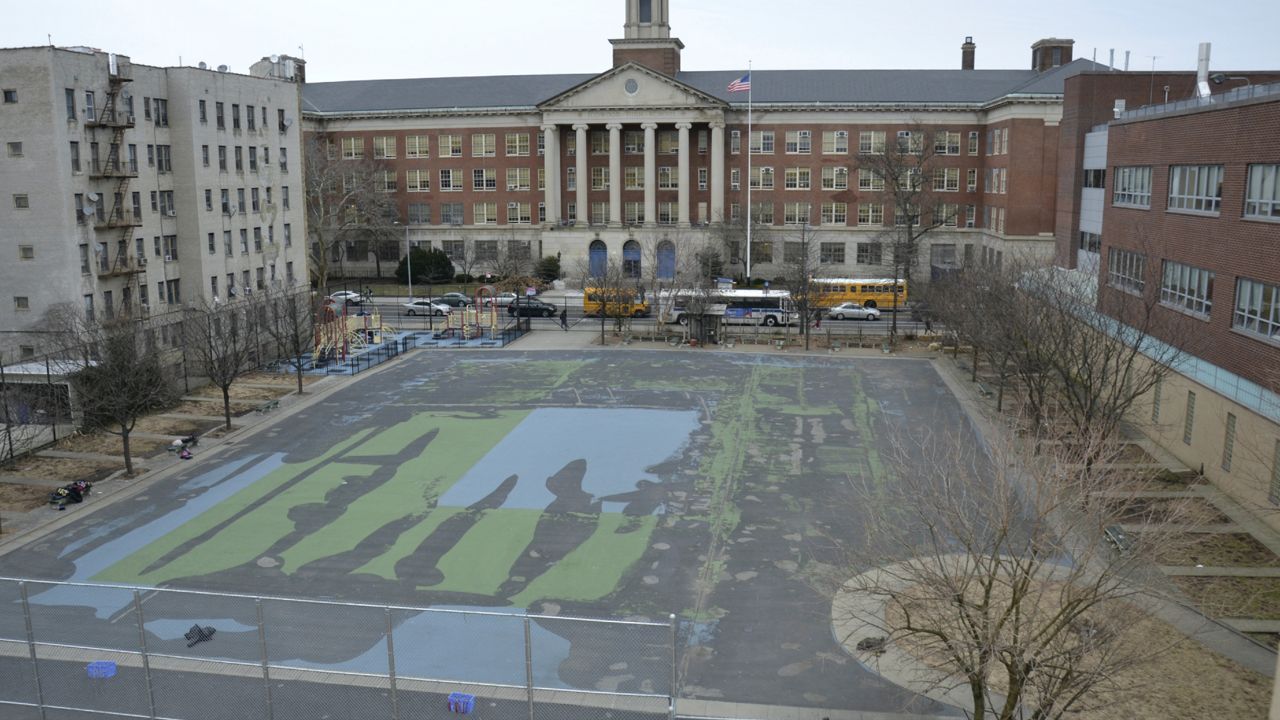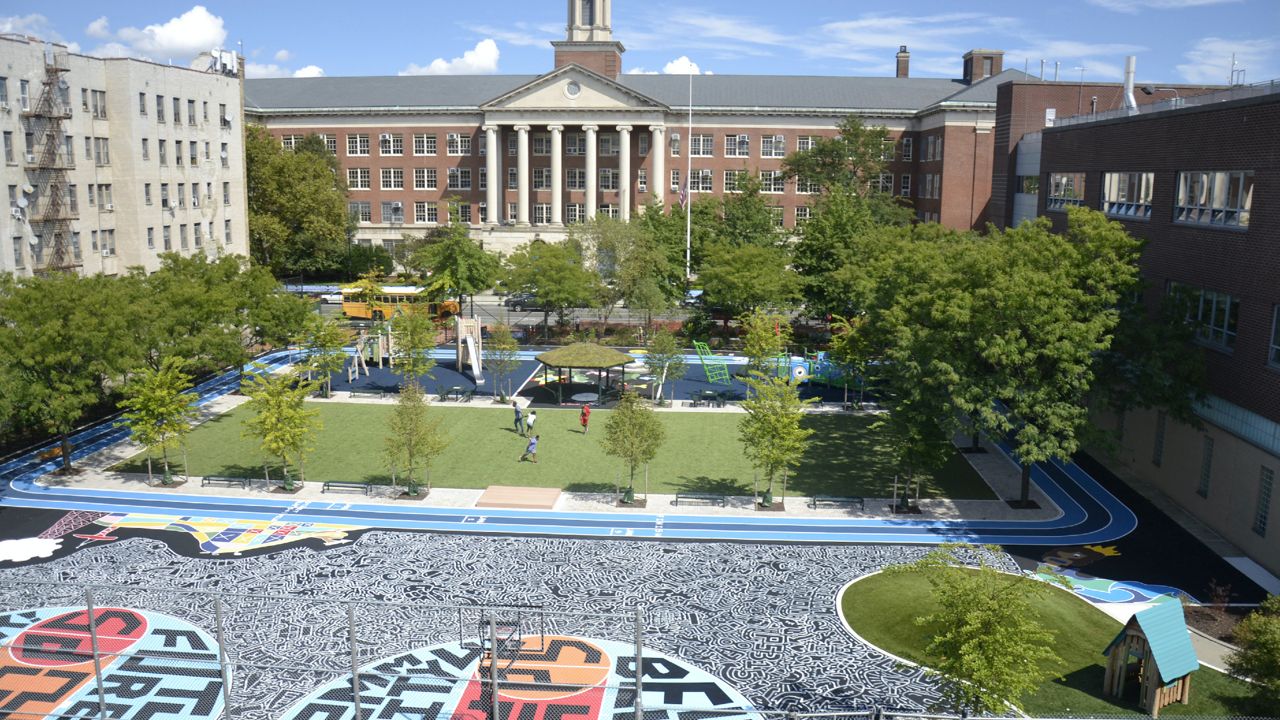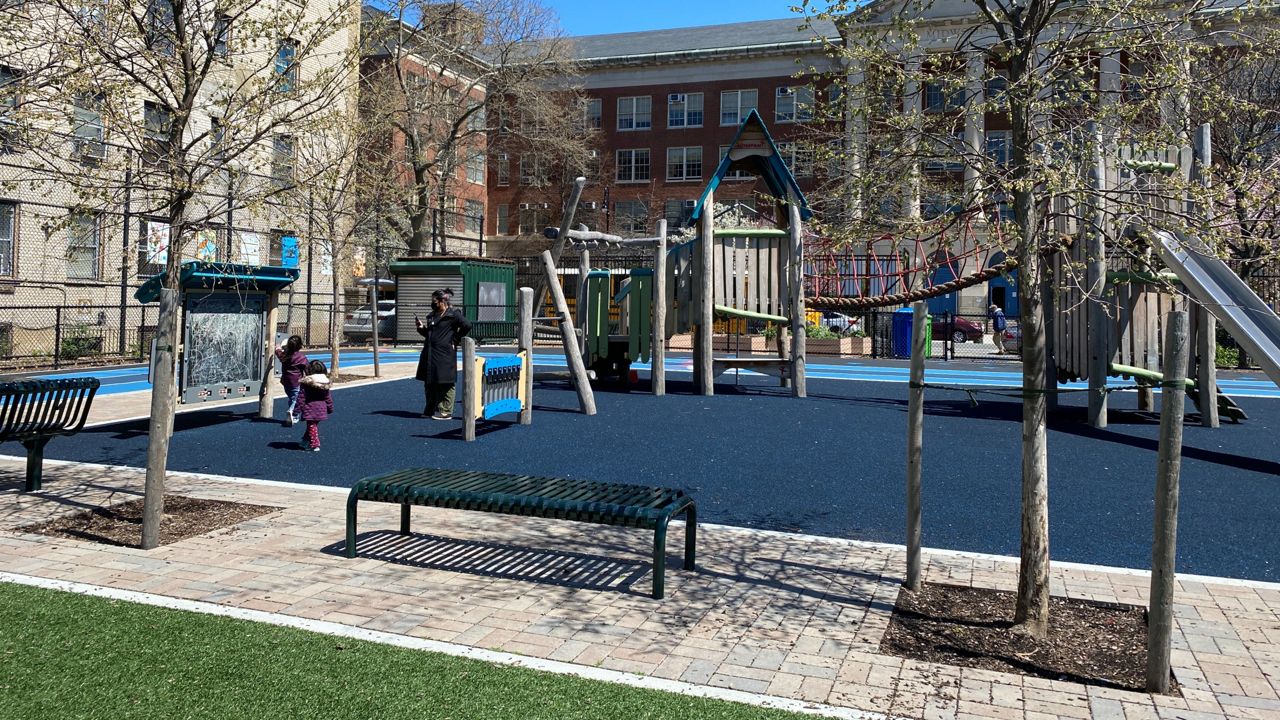On most afternoons, Chrissy Pedrena takes her two daughters to the playground behind P.S. 315 in Midwood, Brooklyn. Though Pedrena grew up in the area, she only started taking her children to the playground last fall, when it reopened after a major renovation.
Green turf and an expanded playground on rubber ringed by a walking track replaced asphalt. Instead of milk crates hung on a chain link fence, the basketball court now has adjustable in-ground hoops and a court surface covered in graffiti artwork.
Pedrena says her older daughter often requests to go to that park, wanting to play with the wheel on one of the jungle gyms that has a built-in speaker that makes fart noises and giggles when you spin it.
“She’ll say, ‘I wanna go to the park that laughs,’” she said.
The renovated park was funded in part by the Trust for Public Land, a nonprofit that buys and repurposes urban tracts and wilderness areas for public use, and is something of a model for what the Trust is proposing in its newly released Park Equity Plan.
What You Need To Know
- A new report is calling for $1 billion to help build 70 new parks and 100 new playgrounds around the city
- The new parks and renovated schoolyards would insure all New Yorkers live just 10 minutes from a park
- Renovating concrete schoolyards would also help make those areas draws for multiple generations, addressing the growing need for public space coming out of the pandemic
- Most mayoral candidates support expanding parks and green spaces, but have differing priorities about how to approach the city's public spaces
The plan calls for major investment in New York City parks, drawing on city, state and federal funds. It comes as the city emerges from a pandemic that redefined the importance of open, public spaces, and as leading mayoral candidates have put expanding public space at the center of their environmental and social justice initiatives.
Carter Strickland, the director of the New York and New Jersey chapter of the Trust for Public Land, said that when they build and renovate new playgrounds around the city, they will take communities to P.S. 315’s playground to inspire them.
“Park usage has gone through the roof,” he said. The pandemic, he added, has “really revealed what we always knew, which is that people need their parks to stay healthy.”
Getting to 100%
The Trust’s new report calls for $1 billion in spending over four years to pay for three main efforts: renovate 100 more schoolyards in the model of P.S. 315’s play area; increase the number and quality of parks in communities of color; and create 70 new parks, bringing the amount of New Yorkers living within a 10-minute walk of a park from 99% to 100%.
Currently, there are about 75,000 New Yorkers who live farther than that from a park, primarily in Staten Island, eastern Queens, southwestern Queens and southern Brooklyn, according to the report.
The report does not include exact sites for the new parks, but a map included with the report shows tentative locations that would be finalized with community input.
The city has steadily raised the percentage of residents within 10 minutes of a park since 2012 when it was at 96%, as well as grown its spending on parks per resident from $152 to $232. But its ranking in green space access has gone down during that same time, according to the Trust, as other major cities have expanded their parks more quickly.
The city has added 400 acres of parkland under Mayor Bill de Blasio’s administration, according to Meghan Lalor, a spokesperson for the Parks department. The department also has several parks in various stages of completion. It is currently constructing Fresh Kills Park on Staten Island, as well as a new portion of Bushwick Inlet Park in Williamsburg, and is designing a new greenway for East Harlem between 125th and 132nd Streets.
A new $6.1 million park by the beach in the southwest corner of Sheepshead Bay is set to open “in the next few weeks,” Lalor said.
The Trust for Public Land report also includes new analysis showing how large the park gap is between marginalized communities and privileged ones.
On average, communities of color have about a third less park space per person within a 10-minute walk than predominantly white communities: about 29 acres versus nearly 45 acres per 1,000 people. Low-income neighborhoods similarly have less park space, with 21.2% less space per person when compared with high-income communities.
“That means those places were more crowded during COVID, the parks don't have shade for hot summers, and the parks aren't as good,” Strickland said.
Now, he said, with the creation of programs like Open Streets and restaurants expanding onto sidewalks and streets, the city needs a plan to make sure that communities that were hardest hit by COVID-19 see long-term investment for state-of-the-art parks that meet community needs.
“There’s been a shift in use that I think has made the time ripe for a park equity plan,” he said.

 After the renovation. (Credit: Maddalena Polletta)
After the renovation. (Credit: Maddalena Polletta)

Mayoral candidates weigh in
The report, Strickland said, is meant to give mayoral candidates some ideas for remaking the city’s parks map -- and encourage them to think about public space beyond simply blocking off roads and letting restaurants put tables on the street.
Nearly every mayoral candidate cites expanding public spaces as a top priority and several link expanding parks to racial and environmental justice initiatives.
Brooklyn Borough President Eric Adams and Comptroller Scott Stringer both say they would create public green spaces out of certain highways that had been built through communities of color by Robert Moses during the New Deal era.
Stringer also says in his plan that he would build 100 new parks in five years, while Kathryn Garcia wants to renovate 100 parks in areas hit hardest by COVID-19.
Maya Wiley and Ray McGuire both support fully funding the Department of Parks and Recreation, which has seen tens of millions of dollars of budget cuts since the beginning of the pandemic, primarily curtailing their maintenance operations.
Yet in areas that need parks the most, there is little space to build them.
Community Board 14, which covers Flatbush and Midwood, including P.S. 315, has the lowest percentage of residents who live within a quarter-mile of a park, according to a 2018 report from New York University's Furman Center.
When you take out the Parade Grounds -- the sports fields below Prospect Park at the very top of the district -- less than 1% of the district is given over to parks, according to a report compiled for the Community Board by a planning fellow in 2017. Citywide, about a fifth of land is used for parks and recreation, according to data from the Trust for Public Land.
That means that dense communities seeking more green space will have to get creative, according to Jo Ann Brown, the chair of Community Board 14: expanding medians, using MTA or library properties and turning the edge of dead-end roads into green space.
“We’re gonna find the most success when we use the spaces that are ineligible for development,” she said.
‘A trip wire connected to a land mine’
Communities like Midwood and Flatbush, as well as the new mayor, will also have to contend with an added complication: the threat of “green gentrification,” when expanding green space in a historically under-resourced neighborhood leads to displacement of the neighborhood’s residents.
The effort to expand green space in places on the edge of gentrification, such as Flatbush and Midwood, is “a trip wire connected to a land mine,” said Greg Smithsimon, a professor of sociology who studies public spaces at Brooklyn College.
“It is absolutely the case that communities of color have less access to parks, need parks,” he said. “It’s also true that real estate value and gentrification can be seeded with access to parks.”
Those communities will need to fight for expanding and renovating parks near public housing, which Smithsimon called “gentrification resistant,” or attaching requirements for adding affordable housing or strengthening rent and eviction controls to new park plans.
One project just getting off the ground in Community Board 14, however, shows how complicated creating new green and open space can be in a city where fleeting access to available space inspires deep passion about how to use it.
A vacant lot at the corner of Church and Bedford Avenues is now the subject of differing -- and for some residents, competing -- visions. Some want to see the lot become dozens of units of affordable housing, while others want a new community garden.
Historical evidence also suggests that the site is home to a burial ground for enslaved Africans, one of a handful that local historians have found throughout the city. Some local residents want to see the site become a memorial to those interred there.
“I think they can live there together,” Brown said of the three different priorities for the site.
While a decision on the lot is possibly years away, she added, the emerging debate is a sign of the intense need for public spaces in neighborhoods like hers and the scarcity of potential sites.
“The future is, how can we utilize every postage stamp we have in the district to make ends meet?” she said.



